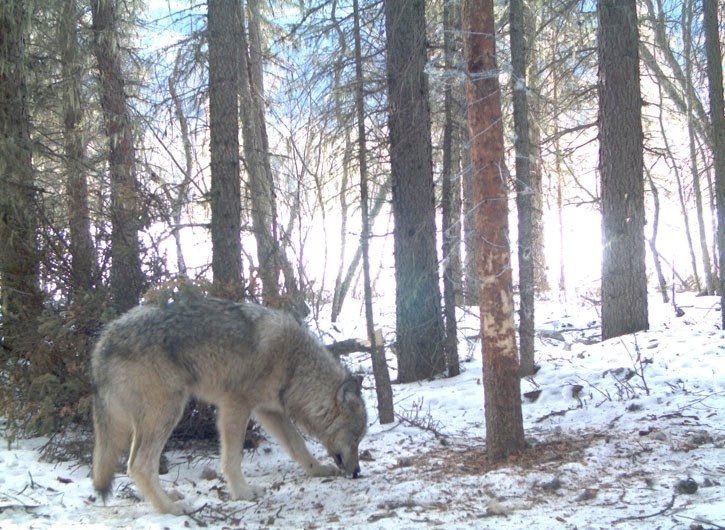KANANASKIS – New research suggests carnivores such as wolves and coyotes may be changing their behaviour and activity patterns to avoid throngs of people and other human activity in Kananaskis Country.
Using data from motion-triggered cameras from previous projects, researcher Sandra Frey investigated animal activity patterns in the busy and developed K-Country and in the more remote Willmore Wilderness Park northeast of Jasper.
While both areas are home to many carnivore species and have similar rugged terrain, she wanted to compare how wildlife reacts to human disturbance in Kananaskis, where there are three million visitors a year and tourism and industrial development, compared to the Willmore area where there is limited human disturbance.
“My research interest was in understanding how human disturbance, the human footprint, alters how wildlife behave and how wildlife interact with each other on the landscape,” said Frey, a Masters student at the University of Victoria.
“My results so far indicate that carnivores are shifting their behaviours, that is, activity patterns in response to human-mediated disturbance, but that these activity shifts manifest in very different and unexpected ways across different carnivore species.”
Camera trapping is a method for capturing wild animals on film when researchers are not present, and has been used in ecological research for decades. In this case, the photos are all time stamped so Frey could tell when the animals were out and about.
The focus of the research was on larger carnivores, including wolves and cougars, as well as smaller carnivores like lynx, fox and different members of the weasel family, such as marten and fisher.
Frey said a species’ daily activity pattern is largely regulated by an internal clock, but there are also environmental cues, such as light, risk of predation or encountering people that can drive changes in when animals choose to be active or not.
She said preliminary findings indicate that carnivores are shifting their behaviour or activity patterns in Kananaskis in response to human disturbance, but it is different for various species.
“We observed that wolves became more nocturnal, which was expected, while martens increased daytime activity and coyotes unexpectedly became indiscriminately active at all hours of the day,” she said.
If carnivores are behaving differently on busier and developed landscapes, Frey said then this also likely alters the way carnivore species interact and compete with each other.
For example, she said smaller carnivores such as lynx, fox and weasels in Kananaskis might not be able to avoid coyotes as well anymore since coyotes are active at all hours of the day on this disturbed landscape.
“Carnivore activity shifts might also have implications on the rest of the ecological community. For example, decreased daytime activity of wolves on disturbed landscapes releases diurnal prey species from the predation pressure by wolves,” said Frey.
“Over time, these changes to the competitive interactions between carnivores might favour some carnivore species over others, ultimately altering the capacity for carnivore species to coexist on disturbed landscapes.”
Frey said it’s known that human disturbance often shifts the distribution of wildlife on the landscape, as well as population sizes.
“But an increasing number of studies, including this one, also highlight that there are a lot of behavioural changes that happen too,” she said.
“These shifts can disrupt important mechanisms, allowing for species to reduce competition and coexist on the landscape.”
Specific findings show wolves appear to be shifting their activity to nighttime in Kananaskis compared to wolves in the Willmore.
“I believe that’s because they potentially didn’t want to bump into people in the daytime,” said Frey.
“We know humans are more active in the daytime and so, given that, it’s very possible that shift directly represents a response to increases in human activity that manifests during daytime hours.”
With coyotes, the research showed activity of these animals peaked over sunrise and sunset in the Willmore area, whereas coyotes in Kananaskis are being indiscriminately active at all hours of the day.
“That’s really interesting, because whatever environmental cues are driving coyotes in the Willmore to restrict their activity more towards twilight, those processes are not at play in Kananaskis Country,” said Frey.
“Perhaps in Kananaskis, the limited activity of apex predators is now allowing coyotes, which would be preyed upon by wolves or cougars, to be able to expand activities during the day,” she said.
The finding that most surprised Frey was an activity shift for marten, a member of the weasel family.
In the Willmore, marten activity dropped around sunrise, but picked up again at sunset, whereas it was almost an inverse of that in K-Country.
“I don’t think in this case it’s a direct response to human presence, but it could be a cascading indirect response,” she said.
The camera data was collected for previous projects in the Willmore Wilderness in 2006-2008 and from Kananaskis from 2011-2014.




